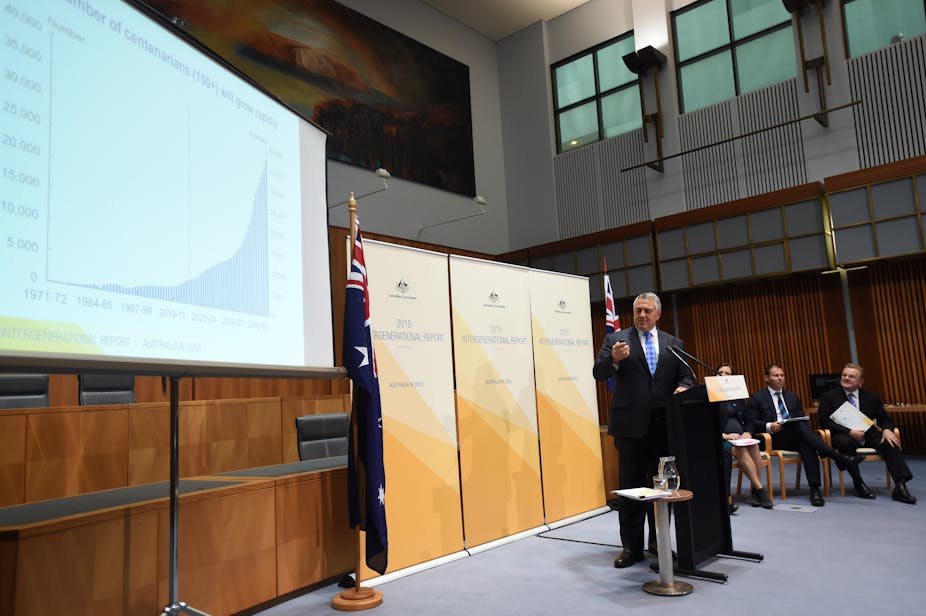The Charter of Budget Honesty, passed when Peter Costello was treasurer in 1998, introduced a number of innovations to fiscal reporting and strategy. The Pre-election Economic and Fiscal Outlook (PEFO), regular intergenerational reports (IGRs), and a medium-term fiscal strategy were all included in the Charter. After 17 years, are these measures supporting sound fiscal policy? There’s plenty of room for improvement.
Pre-election Fiscal and Economic Outlook
The PEFO is produced by the Treasurer’s advisers. It is intended to provide an apolitical view of the fiscal and economic situation at the time of federal elections. Although it does not get the attention it deserves in the election campaign, and afterwards, it serves a useful brake on some of the more extravagant claims of government and opposition.
Intergenerational Reports
By contrast, the IGR is the Treasurer’s document. In providing 40-year projections, Mr Hockey can choose which measures to include in the projections, which issues to discuss, and the assumptions to make regarding demographic change, economic growth, and so on. As a result, projections in successive reports can vary widely, reflecting political requirements of the time.
Political messaging sometimes gets the better of even short-term forecasts – Agriculture Minister Barnaby Joyce’s forecast of a A$100 leg of lamb after the carbon tax provides a colourful illustration. When it comes to 40-year projections the effects of even a small degree of political influence can lead to major changes to long-term outcomes.
The effects of massaging could be reduced by following New Zealand, where the long-term projection model is a public document and analysts can use it to test alternative assumptions.
But this is not the only problem.
Given the uncertainty involved, a 40 year time horizon is far too long. The impact of fiscal policy changes can only be effectively assessed over a much shorter period.
Second, the federal IGR is silent on the implications of the projections for the financial position of the States. Over long time horizons, federal and state governments are joined at the hip. It is misleading to treat them as being independent. For example, the present IGR assumes that from 2017-18 onwards, real per person funding from the Australian government for public hospitals will remain constant. The burden falling on State budgets is likely to rise rapidly. What appears to be a positive outcome for the federal IGR is a negative long-run outcome for the States.
A related point concerns the treatment of infrastructure. For example, the accounting treatment in the IGR excludes funding for NBN Co. It also effectively excludes infrastructure spending funded by the Commonwealth but undertaken by the States – these are treated as current spending in the Commonwealth accounts.
The treatment of infrastructure is important because, as popularly conceived, equity requires that future generations don’t pay for our day-to-day spending. The golden rule of fiscal policy requires current generations to pay for day-to-day spending, including depreciation of infrastructure and interest on debt. Additions to long-lasting infrastructure which yield a return greater than the cost of capital (giving benefits to future generations) are financed by issuing debt.
It would be helpful, therefore, if the IGR focus on net debt were supplemented by data on infrastructure spending by, or on behalf of, the Commonwealth.
Medium-Term Fiscal Strategy
The third innovation in the Charter was to set the objective for fiscal strategy of “achieving budget surpluses, on average, over the economic cycle”. This sits oddly with the requirement to produce an intergenerational report. Were the medium-term strategy to be achieved, there would be no need for an IGR, at least from a budgetary point of view.
The medium-term strategy should be strengthened and given more emphasis than the IGR. A fixed time horizon should be chosen – say ten years. This would overcome the problem that the length of an economic cycle cannot be predicted with any accuracy and, even in hindsight, cycles are not unambiguously defined.
A classical economic cycle measures the interval between two recessions; in turn, a recession is indicated by two consecutive quarters of negative real GDP growth. The current, incomplete, cycle in Australia began in March 1992, an interval of 23 years. Since then, there have been quarters in which growth has fallen well below trend, but none in which real GDP has declined.
Alternatively, a “growth cycle” measures the interval between two periods in which real GDP growth falls below trend. Taking the 25-year average as a measure of trend, there have been five and possibly six cycles since 1992.
Adopting a fixed, policy relevant, time horizon would avoid these problems. Making the projection model publicly available would promote apolitical analysis. Distinguishing between current and capital expenditure would help discussion of intergenerational equity. One last problem – how to produce fiscal projections in a federation. That’s a tough one.

